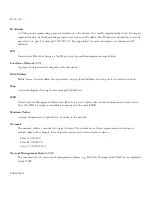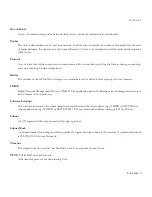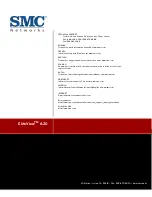
G
LOSSARY
Glossary-2
IP Address
A 32-bit quantity representing a point of attachment to the Internet. It is usually represented by four 8-bit integers
separated by dots. Each decimal integer represents a byte in an IP address. The IP address is divided into a network
part and a host part. For example, 192.9.211.151. See Appendix E for more information on Internet and IP
addresses.
IPX
Internetwork Packet Exchange is a NetWare protocol providing datagram message delivery.
Local Area Network
(LAN)
A group of interconnected computers and other devices.
MAC Address
Media Access Control address that represents a unique physical address for each port in a local area network.
Map
A network diagram showing devices managed by EliteView.
MIB
An acronym for Management Information Base. It is a set of objects that contain information about the device.
Note that MIB-2 is simply a subordinate component of the overall MIB.
Multicast Packet
A packet transmitted to a specified set of nodes on the network.
Netmask
The netmask divides a network into logical subnets. This number uses a binary representation to include or
exclude address. For example, these netmasks correspond to various internet classes:
Class A: 255.0.0.0
Class B: 255.255.0.0
Class C: 255.255.255.0
Network Management Station
(NMS)
The computer used to run network management software, e.g., EliteView. Messages from EliteView are displayed
on the NMS.
Summary of Contents for ELITEVIEW
Page 1: ...MANAGEMENT GUIDE EliteViewTM 6 20 SNMP Based Network Management Softwarefor Windows ...
Page 2: ......
Page 8: ...iv ...
Page 20: ...INTRODUCTION 1 4 ...
Page 66: ...NETWORK TOOLS 5 18 ...
Page 106: ...COLLECTING DATA WITH LOG MANAGER 7 22 ...
Page 121: ...RMON UTILITIES 9 7 ...
Page 156: ...TYPICAL ELITEVIEW APPLICATIONS A 8 ...
Page 180: ...TECHNICAL REFERENCES D 4 ...
Page 188: ...SPECIFICATIONS F 4 ...
Page 222: ...ERROR MESSAGES I 30 ...
Page 231: ......







































